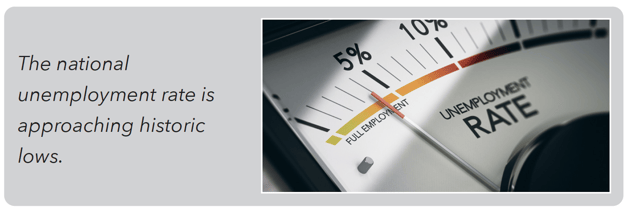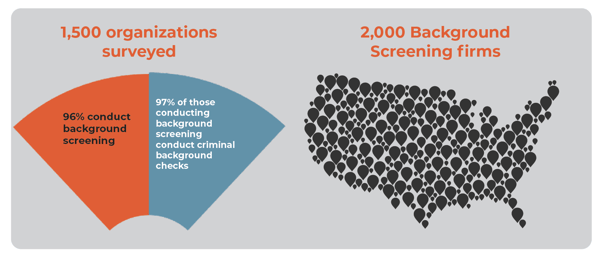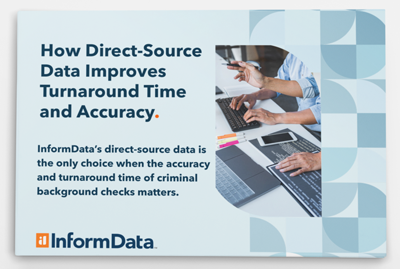InformData’s Direct-Source Data® is the only choice when the accuracy and turnaround time of criminal background checks matters.
How Direct-Source Data Improves Turnaround Time and Accuracy
Contents
Introduction
Criminal incidents can happen anywhere, but as a consumer reporting agency (CRA), you do not have the resources to dispatch researchers to every single court in the country. You must rely on third-party sources of criminal background information.
This is one of the most meaningful decisions you face as a CRA. Your company’s ability to meet deadlines, uphold quality standards, and satisfy your end-users depends on your data provider. Who can you trust?
In this eBook, we propose going direct to the source — or as close to the source of criminal records as you can get. Unnecessary layers, middlemen, between you, your end-users, and county-level criminal records data can only impede your efficiency, damage your accuracy rating, and increase your costs. Direct-Source Data® gives CRAs the lowest cost, lowest turnaround time and highest levels of security for the information they provide to their customers to make business critical hiring, tenancy and credentialing decisions.
Read on to discover how InformData helps CRAs like yours break down barriers to using as much Direct-Source Data for background screening as possible — and how getting close to the data will help your business thrive in 2022 and beyond.

The market opportunity
The criminal background screening market is brimming with opportunity. So far 2022 is looking a lot like 2021 when it comes to the strong demand for labor.
Businesses have reopened, COVID-19 vaccines are readily available and with a widespread relaxing of the stringent guidelines that sidelined many service-oriented businesses for most of 2020, the National unemployment rate is approaching historic lows (according to the U.S. Department of Labor and Statistics.)
Businesses across the country are hiring
For consumer reporting agencies (CRAs), the continuing demand for quality workers represents an economic opportunity. And if the pre-COVID hiring landscape returns, this opportunity will be significant.
As we reported in an ebook that we published just before the start of the COVID crisis in early 2020, the demand for background screening has grown rapidly over the past two decades.

A strong pre-COVID economy, along with a low unemployment rate, partially drove the trend. Other factors included the rise of the gig economy, a younger generation of workers who change careers more frequently, and increased attention on workplace safety.
A national HR.com survey found that “background checks are nearly universal.” Among the 1,500+ organizations surveyed, 96% said they conduct some type of pre-employment screening, and among those, 97% conduct criminal background checks.
As companies look to recover strongly over the coming months, it will be more important than ever to ensure they have employees they can count on. These employers will turn to CRAs to provide accurate and timely criminal background checks.
However, while demand is likely to grow for criminal background screening, the competition will remain fierce. There are nearly 2,000 background screening firms on the market. To make the most of the current opportunity for growth and profit, CRAs must impress their end-users by performing in the areas employers value highly.

What do employers expect from CRAs?
Employers have plenty of options to choose from when it comes to ordering criminal background reports. In this buyer’s market, end-users can afford to set the bar high. The best way to ensure your service always exceeds the high bar is to treat data sources like a supply chain. If you’re using Direct-Source Data, you can gain visibility that lets you manage your data like a supply chain, making it more predictable, reliable and secure. This can be the difference between your CRA standing out from others in a crowded market.
Criminal background check buyers expect their providers to excel in five areas which can be assured by treating data sources like a supply chain:
1. Accuracy
A single omission on a criminal background report can expose an employer to a significant amount of risk. For example, if a truck driver whose license has been suspended because of a DUI causes an accident, the driver’s employer could face severe fines and costly lawsuits.
Moreover, the cost of replacing an employee after they’ve already been onboarded can be steep (as much as twice the employee’s salary, according to one estimate).
Companies need to be sure they have the right people in place from the get-go, and therefore, they demand near-100% accuracy from their CRAs.

2. Turnaround time
Other than accuracy which is a given, no KPI matters more to background screening end-users than turnaround time. Timing is everything. The longer an employer must wait for a completed criminal background check, the longer the company is forced to function while shorthanded — a recipe for lost productivity and revenue.
Typically, turnaround time is measured using two metrics:
- Hit turnaround time. The amount of time to complete and report on a search that results in a criminal record. These usually take longer because they involve gathering, transmitting, and formatting data.
- Clear turnaround time. The time it takes to report on a background check that found no criminal records.
Many end-users understand that an average of these two numbers will fail to tell the whole story. An ultra-quick clear turnaround time will bring your overall turnaround time down, but it won’t say much about how quickly your organization can provide results when they really matter — when there is something to report.
When it comes to timing, employers aren’t merely interested in how quickly you can provide results but in how well you can stick to a timeline. In other words, if you say, “This search will be ready in three days,” and it takes five days, end-users will hold it against you.
At InformData, we call this metric “estimated completion date accuracy,” or ECD accuracy.
We find that many of our CRA partners are more interested in ECD accuracy than turnaround time. We’ll hear, “I don’t really care how long it takes as long as it’s reasonable. But I have to be able to set expectations with my end-user.”
3. Customization
Every employer has a different business model and their own set of customers. And therefore, every employer may have different requirements regarding the format of their criminal background reports and the information included. CRAs frequently field requests to customize their reports to meet their end-users’ unique specifications.
For example, an employer may tell their CRA, “If the candidate has three misdemeanors in the past two years, we won’t hire them.” However, the meaning of “misdemeanor” varies from jurisdiction to jurisdiction. In Minnesota, every speeding ticket is considered a “petty misdemeanor.”
Some employers may ask their CRA to weed out traffic-related misdemeanors. Others (those looking to hire drivers, for instance) may want to take them into consideration. A CRA should be prepared to tailor its findings for both sets of end-user.
4. Transparency
The criminal background check process shouldn’t be a black box. For scheduling, compliance, and to protect themselves against lawsuits, employers need to be able to follow a criminal background check from start to finish, with complete documentation recording every step along the way.
5. Cost-effectiveness
While quality and speed are paramount, cost is always going to be a major consideration in a company’s choice of vendors. Successful CRAs optimize their processes to minimize their own expenses — without sacrificing reliability and accuracy — while passing the savings on to their end-users.
A critical decision for CRAs
It would not be feasible for most CRAs to deploy researchers to each of the country’s 3,000-plus counties. Nor is it recommended to manage a network of hundreds of vendors. So, most CRAs turn to a third-party provider of criminal background information.
This is one of the most crucial choices a CRA can make.
To exceed their end-users’ expectations in the five areas outlined above, a CRA needs a partner that will get them close to the data.
What do we mean by “close to the data?” We mean a direct line between you, your end-users, and the courts, with as few layers of separation as possible. In other words, Direct-Source Data is always the best data for fast, reliable, secure background screening.
Getting close to the data will help your CRA:
- Reduce errors. Minimizing the number of hands your data passes through also minimizes the chances for it to be transposed, entered incorrectly, or transmitted to the wrong person.
- Improve turnaround time. Fewer steps mean a faster process and, more importantly, greater control. You will not be stuck waiting for third-parties to follow through on your commitments.
- Accommodate customization needs. Third-parties tend to be set in their ways, presenting results in generic formats designed to satisfy the widest range of customers. The closer you get to the data, the more finely you can calibrate background screening reports to meet your end-users’ specific requirements.
- Provide full transparency. There are no mysteries when you get close to the data. Everything is available to be audited and analyzed. Status tracking becomes easier. (It’s difficult to follow a researcher’s every move when there are multiple layers involved. It’s also harder to communicate with that researcher.)
- Offer competitive pricing. It should go without saying, but the fewer layers between you and the direct source of criminal background information, the fewer people you have to pay. Not only that but when you standardize on Direct-Source Data, InformData can accurately model the cost of the searches you do. Using these models, InformData can offer you a pricing model that tracks with how you charge your customers. We call this CRA-friendly pricing. This allows you to manage your margins better and be a more competitive and profitable CRA.

How InformData gets you closer to the data
For over two decades, the background screening experts at InformData have been working to break down the barriers that separate our CRA users from the direct sources of criminal records data.
Your end-users are counting on you to help them make informed and efficient hiring decisions. Our goal is to help you supply your end-users with the high-quality criminal background information they need, when they need it, in whatever format they require.
A third-party with conflicting priorities shouldn’t define your customer relationships. We aim to give you complete control, and we can because we have complete control of our data.
No other organization covers the entirety of direct-sourced court data in the United States while providing the level of flexibility, customizability, and transparency you need to follow all your user-driven guidelines on research and reporting.
At InformData, we’ve developed (and are continually improving) a three-tiered system designed to get our users as close to the data as possible in every jurisdiction.
In the following sections, we describe each of the three levels in our system, ranked in descending order according to how many jurisdictions each method covers and how close our system gets to the raw criminal background data.
1. Background screening automation
Before 2012, when InformData first set out to automate criminal background checks, the process of searching court websites for arrest and conviction records depended entirely on the manual effort of human researchers. We recognized that manual research was labor-intensive, slow, prone to error, and prevented our background-screening company clients from accessing the best data available.
Thanks to the hard work and innovation of our software engineers and background screening experts, we pioneered intelligent systems that “scrape” county-level data for criminal information, replacing human researchers with intelligent bots (which we call “agents.”). Never content to rest on our laurels, we completely rebuilt our automation platform from the ground up in 2017 to align with the way modern court feeds are designed and to serve our customers even better. Further enhancements to our automation platform made in 2021 include a methodology we call the API First Framework. Where our intelligent scrapers optimize the acquisition of data, the API First Framework formalizes automated procedures for making high performance, secure, machine-to-machine connections from acquired data to your workflow system. This creates the most reliable, secure, high performance path from data to your customers possible.
How background screening automation works
Our philosophy is, if it can be automated, it should be automated (more on the benefits of automation below). But according to our very high standards, not every online source can be automated.
We continuously monitor all the sites we automate to ensure they provide the complete information you require, covering the time periods you need. If a site fails to meet our quality standards, we do not automate it. We know you, as a CRA, have to stand by the accuracy of your reports, so we stand by the accuracy of our data.
Still, our direct-source automated court research solution covers more than 1,800 county-level jurisdictions through real-time court data extraction and screen scraping. Currently, we can complete about 60% of U.S. jurisdictions through automation — although that percentage is sure to climb as we optimize our system and courts modernize over the coming years.
How automation gets you closer to the data
Automated criminal background checks get you closer to the data than any other method. This is because our intelligent agents and API First Framework completely eliminate the middlemen.
In the automated background check process, the information goes electronically direct from the source to you (and ultimately, to your end-users). There is no inefficient, error-prone human chain involved with retrieving the data, copying down the data, transmitting the data, or entering the data into the system.
The benefits of automation
Automated criminal background screening is nearly instantaneous. Because no one is required to physically go to a court or even visit a website, the information can be delivered to you in a matter of moments (as opposed to the hours or even days you would wait for manual research results).
Automated research is also less error-prone than manual processes. Even the most careful researcher will misspell a name on occasion or enter the wrong information on the wrong field. Computerized agents get it right every time.
We should point out that, should you or your end-users have special customization requirements, our human team is ready to step in to translate the raw automated results into any format you request. Some customization can be handled by the automated solution, as well, although more precise and complex customization still requires the human touch.
It’s all up to you: how far back you want the search to go, the types of records you would like to see, the identifiers you require, and so on. (We can even customize background screening reports on a by-customer basis.)
Our automated system also offers the complete transparency you would expect from a data supply chain, with an HTML audit trail and web snapshots of every automated search.
2. Our proprietary research network
As we explained above, not every criminal jurisdiction is up to our automation standards. Some courts don’t have a website at all or fail to meet our quality standard for whatever information they automate. For the vast majority of these cases, we maintain a network of full-time trained researchers who work only for InformData.
How our proprietary research network works
We place our research teams where they will have the most impact, starting with the most densely-populated metropolitan areas. By targeting strategic areas with large volume concentrations, we can ensure direct coverage of the vast majority of the American population.
In fact, our internal processes (our automated solution and our proprietary research network) provide access to 90% of the data used for criminal background reports. In the future, that percentage may be higher. We are currently expanding our network to cover entire states so that no county — no matter how sparsely populated — goes uncovered.
All our proprietary researchers are locals who know their regions well. Most live within 20 miles of their county’s court.
We expect the utmost level of professionalism from the members of our proprietary research team.
To become an InformData researcher, individuals must complete our rigorous researcher certification program, which includes classroom and on-the-job training. They must also demonstrate our company values, such as positivity, honesty, and the desire to improve.
How do we maintain quality control throughout our proprietary research network?
In a word, process. Process that we monitor and enforce consistently. But more specifically, the members of our research network are not independent contractors. They work for InformData (and no other providers of background screening information) as salaried “W2” employees. Thus, we can monitor their performance and work directly with our researchers and their supervisors to maintain and improve quality.
We monitor productivity, accuracy, turnaround time, and other key metrics. We expect our proprietary research network to achieve an accuracy rate of 99.95%.
A key component of our quality control system is our search management and reporting tool (SMART). We developed the SMART software in-house with tremendous input from the members of our proprietary research network.
SMART not only allows our researchers to enter data and create and share reports efficiently through a standardized system, but its powerful error-proofing mechanisms ensure the integrity and quality of the data. For example, if a disposition date comes before a file date, the SMART system will red flag the occurrence as a potential quality issue.
How our proprietary research network gets you closer to the data
It comes down to control. At InformData, we have complete control over our proprietary research network and the process it operates under. It’s part of our data supply chain. The data flows from the courts, to our researchers, to our reporting tool, through any customization steps, to our CRA partners, and finally to their end-users.
At no point does an outside entity touch the data — meaning every step along the way must meet our sky-high standards for quality, accuracy, and efficiency.
The benefits of InformData’s proprietary research network
Most other criminal background screening research vendors employ very few — if any — full-time researchers. Instead, they partner with local, regional, or national third parties. There are many downsides to this approach.
For example, when you outsource to a third party, you put your company in competition with all the other customers who outsource to the same provider. There’s no guarantee the third party will prioritize your data. If a third party gets bogged down with someone else’s work, you typically have no choice other than to wait your turn.
Contrast this with InformData’s direct-source network, the members of which all answer directly to us (and therefore, to our client's needs).
Another drawback to outsourcing is the lack of customization options. Often, with a third party, you get what they give you.
For example, in Texas, people who bounce checks for more than $5 may be charged with misdemeanor theft. Your end-user may ask you to weed out minor charges like that — but many third-party research firms will not be eager to comply. For the sake of simplicity, most third parties choose to offer the same standardized reporting format to all their customers.
Responsiveness is also an issue when working with third parties. At InformData, we connect with the members of our proprietary research network daily. With a third party, if you have a question or concern, you may spend days waiting for an answer while the provider deals with other background screening companies.
3. Our certified third-party research partners
InformData’s internal research processes cover about 90% of county-level court data in the United States, either through our proprietary research network or our direct-source automated court research solution. The remaining 10% largely represents remote, less densely-populated geographic areas that have yet to modernize their court records or where it would be inefficient to assign a team of full-time researchers.
To guarantee our users access to 100% of the criminal background screening information they require, we cover this small slice of data through partnerships with reliable, highly-qualified, fully-vetted third-party researchers.
How our vendor management capabilities work
We identify and manage the most skilled third-party criminal background researchers in the country so that our users don’t have to.
We demand the same high standards from our third-party partners as our direct employees. That means they must be responsive, accurate, and professional. Each of our third-party partners has completed our vendor certification program.

How our certified third-party vendors get you closer to the data
When choosing partners for our third-party network, we opt whenever possible for local operations that understand their jurisdictions and don’t have to answer to administrators in far-away cities.
Again here, this allows us as much control of the data as possible. We can work with our local partners to customize reports as our clients need them. And when there are issues, delays, or special requests, we can communicate directly with our partners rather than navigating layers of go-betweens.
The benefits of InformData’s vendor management program
From the high plains of Wyoming to the frigid Alaskan interior, wherever criminal convictions occur, your end-users need to know about it. Our certified third-party network ensures nothing falls through the cracks. We’ve built out our third-party network to reach the critical last 10% of coverage you need to provide your end-users with absolute confidence in their hires.
We only work with vendors who have earned our trust and who are willing to collaborate with us to prevent errors, minimize turnaround time, and serve our customers — and their end-users — by committing to thoroughness, adaptability, and transparency. In other words: the best in the business.
InformData: By the numbers
What is possible when you get close to the data by standardizing on Direct-Source Data for your background screening? We invite you to judge InformData’s three-tiered approach by the quantifiable results, all of which far outclass our competitors.
|
1,800+ |
Automated court research jurisdictions |
|
60% |
Portion of criminal records completed via automation. |
|
100% |
Percentage of our data that is direct-sourced. |
|
98% |
Our on-time performance for court research. |
|
7.92 hours |
Our average turnaround time using |
Is your CRA ready to promise faster turnaround time, more accurate results, more flexible customization options, and competitive prices? Then you’re ready to get closer to the data with Direct-Source Data from InformData.

